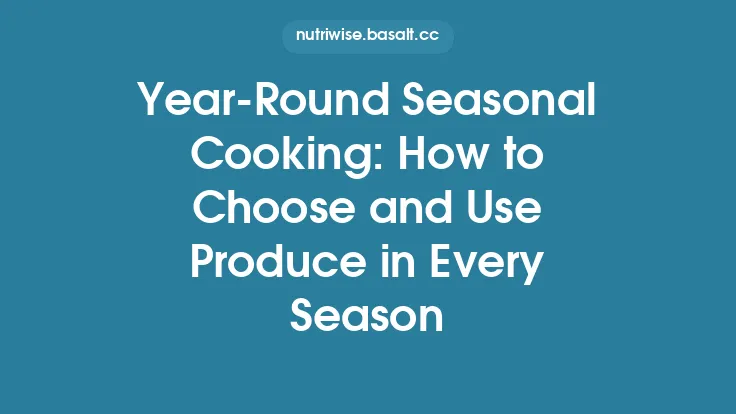Low‑histamine cooking isn’t a fleeting diet trend; it’s a sustainable approach that lets anyone—whether managing histamine intolerance, mast‑cell activation syndrome, or simply looking to reduce inflammatory triggers—enjoy flavorful, satisfying dinners throughout the year. By understanding the science behind histamine, mastering food selection, and employing smart kitchen practices, you can build a repertoire of meals that stay fresh, tasty, and safe no matter the season.
Understanding Histamine and Its Role in Food
Histamine is a naturally occurring biogenic amine that plays a crucial role in the body’s immune response, gastric acid secretion, and neurotransmission. While the body normally breaks down histamine efficiently via the enzyme diamine oxidase (DAO) and, to a lesser extent, histamine‑N‑methyltransferase (HNMT), many people experience reduced DAO activity due to genetics, gut dysbiosis, certain medications, or chronic inflammation. When histamine accumulates, symptoms can range from mild (headaches, flushing, itching) to severe (hives, gastrointestinal distress, asthma‑like attacks).
In the culinary world, histamine levels rise in foods that are:
- Aged or fermented (e.g., aged cheese, cured meats, soy sauce)
- Stored for long periods (especially at warm temperatures)
- Naturally high in histamine (e.g., tomatoes, spinach, eggplant, avocados)
- Histamine‑releasing (e.g., citrus, nuts, chocolate)
A low‑histamine dinner plan therefore focuses on fresh, minimally processed ingredients, rapid cooking methods, and proper storage to keep histamine formation at bay.
Core Principles of Low‑Histamine Dinner Planning
- Prioritize Freshness – Purchase produce and protein on the day you plan to cook, or freeze it immediately if you can’t use it within 24‑48 hours.
- Choose Low‑Histamine Staples – Base meals around foods consistently shown to be low in histamine, such as fresh poultry, most white fish, most fresh vegetables (except the high‑histamine list), rice, quinoa (in moderation), and certain tubers.
- Avoid Common Triggers – Steer clear of aged cheeses, cured meats, fermented condiments, and leftovers that have sat for more than a day.
- Control Cooking Time & Temperature – Over‑cooking can increase histamine formation; gentle sautéing, quick stir‑frying, steaming, and grilling are ideal.
- Implement Proper Storage – Cool cooked foods rapidly (within 2 hours) and store in airtight containers in the refrigerator for no more than 24 hours. Freeze portions you won’t eat within that window.
Building a Low‑Histamine Pantry
A well‑stocked pantry reduces the temptation to reach for high‑histamine shortcuts. Below is a checklist of pantry items that are generally safe for low‑histamine cooking:
| Category | Examples |
|---|---|
| Grains & Starches | White rice, basmati rice, millet, sweet potatoes, carrots, parsnips, pumpkin (fresh) |
| Legumes | Fresh green beans, peas, lentils (cooked and used immediately) |
| Proteins | Fresh chicken breast, turkey, white fish (cod, haddock, pollock), fresh pork tenderloin |
| Fats & Oils | Olive oil, coconut oil, avocado oil (use fresh avocado oil, not aged) |
| Herbs & Spices | Fresh parsley, chives, thyme, rosemary, basil (use fresh, not dried), ginger, turmeric, cumin (ground, fresh) |
| Acidic Condiments | Fresh lemon or lime juice (use sparingly), apple cider vinegar (unfiltered, fresh) |
| Broths | Homemade bone broth (prepared fresh and used within 24 hours) |
| Sweeteners | Maple syrup, pure honey (if tolerated) |
Tip: Label any homemade broth or sauce with the preparation date and a “use by” reminder to avoid accidental storage beyond safe limits.
Seasonal Low‑Histamine Dinner Ideas
Spring: Light, Fresh, and Quick
- Herb‑Infused Grilled Chicken with Asparagus & Rice – Marinate chicken breasts in olive oil, fresh thyme, and a splash of lemon juice for 30 minutes. Grill until just cooked through, then serve over steamed white rice and lightly sautéed asparagus (season with salt and a pinch of ginger).
- Pan‑Seared White Fish with Pea Purée – Use cod or haddock fillets. Sear in a hot pan with a drizzle of coconut oil, then finish with a quick pea purée (blanch peas, blend with a touch of mint, olive oil, and a squeeze of lime). Pair with roasted baby carrots.
Summer: Vibrant and Minimalist
- Zucchini Noodle “Pasta” with Turkey Bolognese – Spiralize fresh zucchini (use within 2 hours to avoid excess moisture). Cook ground turkey with fresh basil, oregano, and a small amount of fresh tomato‑free sauce (e.g., carrot‑based puree). Toss together and finish with a drizzle of garlic‑infused oil.
- Grilled Shrimp Skewers with Mango‑Free Salsa – Use peeled, deveined shrimp marinated in lime juice, ginger, and a pinch of sea salt. Grill quickly and serve with a salsa made from diced cucumber, fresh parsley, and a splash of apple cider vinegar.
Autumn: Warm and Comforting
- Slow‑Cooked Turkey Breast with Sweet Potato Mash – Roast a turkey breast (skin removed) with rosemary, thyme, and a drizzle of olive oil. While it rests, mash boiled sweet potatoes with a bit of coconut milk and a pinch of nutmeg. Serve with steamed green beans.
- Pumpkin‑Free Risotto with Chicken – Traditional risotto can be high in histamine due to prolonged cooking, but a quick “30‑minute” version works: sauté Arborio rice (or substitute with short‑grain millet) in olive oil, add warm chicken broth (freshly made), and stir constantly for 15‑20 minutes. Finish with shredded cooked chicken, fresh parsley, and a dash of lemon zest.
Winter: Hearty and Nourishing
- Lamb Stew with Root Vegetables – Use fresh lamb shoulder, cut into cubes, and brown quickly. Add diced carrots, parsnips, and turnips, then cover with homemade bone broth. Simmer for 45 minutes (shorter than traditional stews to limit histamine buildup). Finish with fresh thyme.
- Baked White Fish with Herb‑Quinoa Pilaf – While quinoa is a moderate histamine food, using it fresh and cooking it just before serving keeps levels low. Bake cod with a rub of rosemary, lemon zest, and olive oil. Serve over quinoa mixed with sautéed spinach (if tolerated) and fresh chives.
Cooking Techniques That Minimize Histamine Formation
| Technique | Why It Helps | Practical Tips |
|---|---|---|
| Quick Sear/Grill | Limits time for bacterial growth that can produce histamine | Pre‑heat pan or grill to medium‑high; cook protein until just opaque. |
| Steaming | Uses gentle heat, preserving nutrients and preventing oxidation | Use a basket over simmering water; cover tightly to retain steam. |
| Blanching & Shock | Stops enzymatic activity in vegetables, reducing histamine precursors | Boil vegetables 1‑2 minutes, then plunge into ice water. |
| Low‑Heat Roasting (≤ 180 °C / 350 °F) | Avoids excessive Maillard reactions that can increase histamine | Roast for shorter periods; check for doneness early. |
| Fresh Herb Finishing | Adds flavor without relying on aged sauces or condiments | Sprinkle chopped parsley, chives, or basil just before serving. |
Meal‑Prep Strategies for Low‑Histamine Dinners
- Batch‑Cook Proteins – Grill or bake a larger portion of chicken or fish on a designated “prep day.” Cool rapidly, portion into airtight containers, and freeze if not used within 24 hours.
- Pre‑Chop Vegetables – Slice low‑histamine veggies (e.g., carrots, zucchini, bell peppers) and store in a single layer on a tray covered with a damp paper towel to maintain crispness.
- Make Fresh Broth Daily – Use a pressure cooker to extract bone broth in under an hour. Strain, cool, and store in the fridge for a day or freeze in portioned ice‑cube trays.
- Label Everything – Include the date, “use by” time, and a brief note on any added herbs or spices. This habit prevents accidental consumption of leftovers that have crossed the safe window.
Troubleshooting Common Low‑Histamine Cooking Challenges
| Issue | Likely Cause | Solution |
|---|---|---|
| Meal tastes bland | Over‑reliance on low‑histamine ingredients can reduce natural umami | Add fresh herbs, a splash of citrus, or a pinch of sea salt at the end of cooking. |
| Food spoils quickly | Inadequate cooling or storage temperature | Cool cooked foods in a shallow pan, then refrigerate within 30 minutes. Keep fridge at ≤ 4 °C (40 °F). |
| Unexpected histamine reactions | Hidden high‑histamine ingredients (e.g., canned tomatoes, pre‑made sauces) | Always read labels; opt for fresh, whole foods. When in doubt, prepare sauces from scratch. |
| Limited variety | Sticking to a narrow list of “safe” foods | Rotate seasonal produce, experiment with different herbs, and explore low‑histamine grains like millet or sorghum. |
| Difficulty finding fresh fish | Local market constraints | Freeze fresh fish immediately after purchase; thaw in the refrigerator overnight before cooking. |
Frequently Asked Questions
Q: Can I use frozen vegetables?
A: Yes, provided they were flash‑frozen at peak freshness and have no added sauces or seasonings. Thaw quickly and use within a day.
Q: Are all herbs safe?
A: Fresh herbs are generally low in histamine. Dried herbs can sometimes contain higher levels due to aging, so use fresh whenever possible.
Q: How long can I keep a cooked low‑histamine dinner in the freezer?
A: For optimal quality and minimal histamine formation, aim for 1‑2 months. Label with the freeze date and use within that window.
Q: Is it okay to reheat leftovers?
A: Reheating can increase histamine if the food has already been stored for > 24 hours. It’s safest to eat leftovers within a day, reheating only once, and to discard any that have been sitting at room temperature for more than 2 hours.
Resources for Ongoing Learning
- Books – “The Low‑Histamine Cookbook” by Dr. Janice Joneja; “Histamine Intolerance: A Guide for the Food‑Sensitive” by Dr. Susan Prescott.
- Scientific Journals – *Journal of Allergy and Clinical Immunology (articles on DAO activity); Food Chemistry* (studies on histamine formation in foods).
- Online Communities – Low‑Histamine Support groups on Reddit (r/LowHistamine) and Facebook; they often share seasonal recipe swaps and fresh ingredient sources.
- Apps – “Histamine Intolerance Tracker” (helps log symptoms and foods); “Meal Planner Pro” (customizable for low‑histamine constraints).
By integrating these principles—understanding histamine chemistry, curating a low‑histamine pantry, employing quick and gentle cooking methods, and planning seasonally—you can create a year‑round dinner repertoire that is both delicious and safe. The result is not just a set of meals, but a sustainable lifestyle that supports comfort, nutrition, and culinary enjoyment every night of the week.





